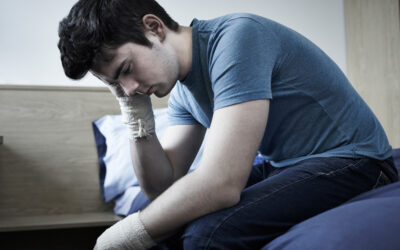Sometimes you’re sad, and that’s OK. There are many things that can make you feel down as a teenager, from a bad grade on your math test to a fight with your best friends. While these are valid reasons to be upset, they only cause temporary negative emotions that will fade. But other times, it can feel like there’s a gray cloud over your head that just won’t go away.
It’s probably not uncommon for you and your friends to casually make statements like, “I’m so depressed” after an inconvenience or letdown. But having a depressive episode is a serious mental health concern that shouldn’t be brushed off or joked about. A depressive episode can make you feel like you’re going to always be sad without a light at the end of the tunnel. But what does an episode actually look like? That’s what we’re here to answer.
We’ll talk about the basics of depressive episodes, what they may look like and the steps you can take to help.
What is a depressive episode?
If you have experienced a depressive episode, you’re not alone. In fact, research shows that about 15% of teenagers experienced at least one depressive episode in 2022.
As you can probably tell from the name, a depressive episode goes hand in hand with major depressive disorder, commonly just known as depression. Major depressive disorder is a mood disorder that causes overwhelming negative feelings. An episode refers to a period of time where you’re having depression symptoms for at least two weeks.
If you have an episode, your mental health provider can determine if it meets the criteria for major depressive disorder, which is described in the American Psychiatric Association’s Diagnostic and Statistical Manual’s fifth edition.
What does a depressive episode look like?
While episodes don’t last forever, they can still cause symptoms that interfere with your ability to handle your everyday routines, such as completing your schoolwork and enjoying quality time with your family.
Depression doesn’t look the same for everyone, which means the episode symptoms don’t either. But it’s important to be self-aware and recognize what an episode looks like for a teen to determine the type of care that would be the most beneficial.
Here are some common symptoms of an episode:
- Persistent and overwhelming feelings of sadness
- Struggling to find enjoyment in activities
- Concentration issues
- Changes in sleeping and eating patterns
- Feeling guilty or worthless
- Suicidality
What to do if you’re experiencing a depressive episode
While it may seem scary to recognize that you’re having an episode, it’s the first step in progressing in your mental health journey. That’s something to be proud of. The next step is to determine which treatment option will provide you with the right amount of care for the severity of your symptoms.
If you’re experiencing suicidality, self-harm behavior, or you’re posing a risk to others, contact emergency services so that you can be admitted into an outpatient treatment facility for 24/7 support during your mental health crisis. You can also call or text the 988 Suicide & Crisis Lifeline by dialing 988.
If you’re not experiencing a mental health crisis, residential treatment or outpatient care is what you’re looking for. Both options help you learn how to alleviate and manage your depression symptoms with talk therapy. They also help you to develop lifelong skills and coping mechanisms that will benefit you long-term.
Residential treatment means that you’re having a long-term stay in a safe and home-like treatment facility while receiving behavioral care. It provides you with the time you need to focus solely on your mental health with structured programs, group sessions and weekly outings to implement your new skills. It’s often used as a transition from inpatient care.
Outpatient treatment is most beneficial if you’ve already had an episode in the past and you want to try to decrease the risk of having a more severe one in the future. It includes psychotherapy to help you get to the root of your depression while working through everyday issues that may contribute to your symptoms. If you’ve been diagnosed with major depressive disorder, outpatient treatment can also include medication prescriptions.
Lightfully Behavioral Health can help you navigate a depressive episode
Having a depressive episode can interfere with every part of your life, from your motivation at school to your connections with your peers. But it’s important to remember that your mental health deserves the same amount of care that you would give the common cold or a sports injury.
When you’re struggling with depression, we have three levels of care that can help, including Residential Treatment, Intensive Outpatient Program (IOP), and Partial Hospitalization Program (PHP), also called our Day Treatment Program.
Change is possible. When you’re ready to take the first step, reach out to our Admissions Concierge Team. We’ll take the next steps together, toward the fullest, brightest version of you.





